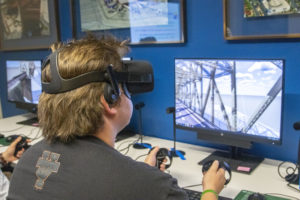
Just as virtual reality has made its way into our everyday lives, changing the way we play, shop, watch videos and use social media, this technology is also transforming the way students learn at Colorado State University.
While the benefits of using VR seem obvious, research to investigate VR as an educational tool is still in an early stage.
Svetlana Olbina, an associate professor in the Department of Construction Management, is integrating VR into the CM curriculum. She is also conducting research aimed at better understanding how the use of VR enhances student learning as compared to traditional methods.
Making virtual reality a reality
In a room on the first floor of the CSU Preconstruction Center, a group of CM students straps on their headsets. With a few clicks of a hand-held trigger device, they find themselves immersed in the three-dimensional house model each of them created earlier in the semester. As they walk through their design, they turn their heads left and right, and up and down, trying to spot errors in their designs.

“There are no handrails on these stairs,” says one.
“Wait! This is much lower than I thought,” exclaims another.
For many of the students, this classroom experience was the first time they dabbled in VR.
“I was so happy to see students’ excitement when they do VR exercises,” said Olbina, who is in her fifth year teaching the CON 131 Graphic Communications for Construction course.
This VR experience was made possible through the generous support of key partners both in the university and industry. In summer 2018, Olbina and her research team received a grant from the CSU Office of Vice President for Research as part of a campus-wide Virtual Reality Initiative to enhance cross-disciplinary research, scholarship, and artistry. This funding enabled the purchase of five VR kits, which made virtual reality a reality in CM classrooms. Additional funding for implementing VR into the curriculum was provided by the College of Health and Human Sciences, Walter Scott, Jr. College of Engineering, Department of Construction Management, Department of Civil and Environmental Engineering, and Mortenson Construction.
Olbina also received a grant from the Beavers Charitable Trust, a non-profit organization whose mission is to assist students in entering the heavy civil construction industry. Part of the funding supported another VR exercise in CON 131 this semester. Students were tasked to walk through a bridge model in VR and identify mistakes, with hopes that the experience would increase their understanding of heavy civil structures and spark their interest in heavy civil construction.
Members of the research team
Led by Olbina, the virtual reality research team comprises Jonathan Elliott, Rodolfo Valdes-Vasquez and John Killingsworth from the CSU Department of Construction Management; Rebecca Atadero from the Walter Scott, Jr. College of Engineering; and Chris Boal from Mortenson Construction.

Through both exercises, Olbina is not only helping students gain a deeper understanding of the construction process, but she is also evaluating the instructional value of using VR. For her research goal, she is hoping to find out if VR can help students to better spot problems in projects compared to other visualization tools such as two-dimensional drawings.
“We always want to improve student learning,” Olbina said. “In construction management education, it’s really about understanding and solving problems. Hopefully, when students visualize better, they will be able to understand better.”
Value of VR in construction management education
As the cost of equipment falls and schools have greater access to technology, VR is playing an increasingly important role in classrooms nationwide. It especially has the potential to reshape construction management education.
Construction management is a highly visual industry that requires understandings of complex spatial relations. However, most of the time students are learning using traditional two-dimensional drawings. Olbina finds this approach challenging for many CM students.

“With two-dimensional drawings, you have to be quite experienced or talented to visualize a building based on its floor plans, sections, and elevations,” said Olbina. “With virtual reality, you quickly get the idea of how the building will look once it’s constructed.”
While creating a 3-D model of a building or a construction site is very helpful, viewing the model on the two-dimensional computer screen doesn’t allow for complete visualization. Virtual reality, however, allows students to step into a design and interact with it exactly as they would during an actual real-life walk-through.
A new frontier
While the market for VR applications is growing at a rapid pace as a new technology, it has yet to enter the construction industry or the classroom on a large scale. With its many possibilities, Olbina feels confident that this could be the next big leap.
“Sometimes the industry is ahead of us, but sometimes they’re looking at us to provide cutting-edge education,” Olbina said. “If our students are exposed to VR while in school, they could be driving change in the industry in the future.”
The Department of Construction Management is part of CSU’s College of Health and Human Sciences.